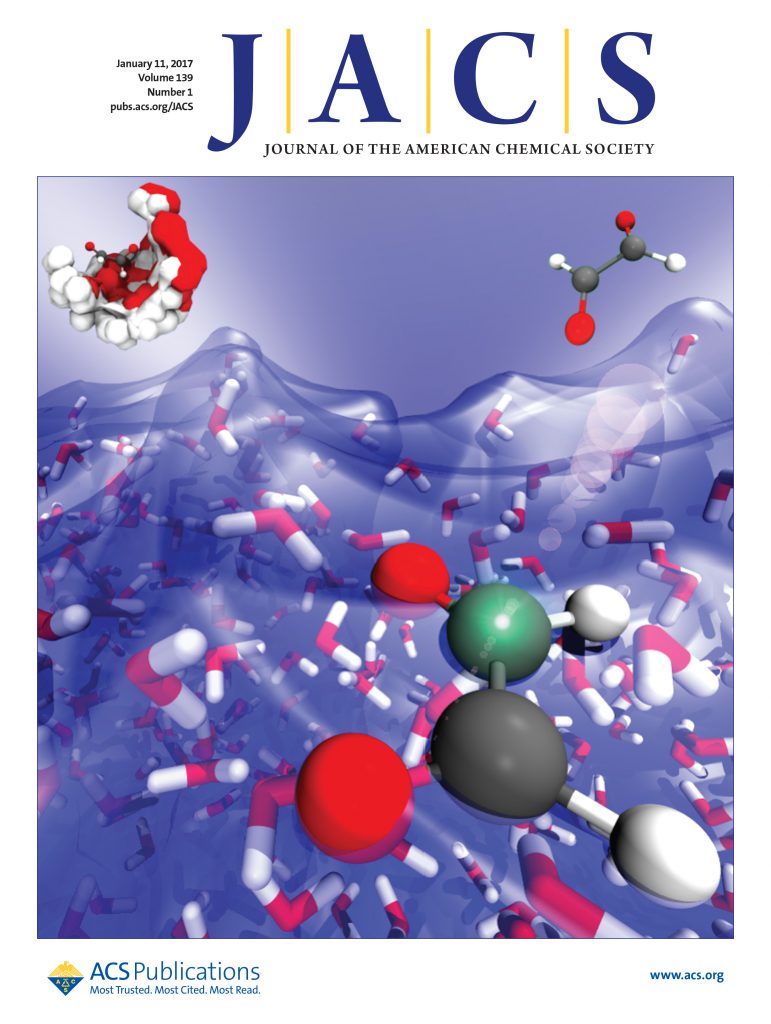Preorganized Internal Electric Field Enables Nucleophilic Attack of a Nonactivated Water Molecule in Thymine DNA Glycosylase.
IF 15.6
1区 化学
Q1 CHEMISTRY, MULTIDISCIPLINARY
引用次数: 0
Abstract
Thymine DNA glycosylase (TDG) is a monofunctional glycosylase, playing an essential role in genome maintenance and in the DNA demethylation pathway. TDG differs from other DNA glycosylases in that it lacks a general base catalyst to activate water nucleophiles, making it appealing to understand its special catalytic mechanism. Through a combination of molecular dynamics (MD) simulations and quantum-mechanical/molecular-mechanical (QM/MM) calculations, we decipher a detailed mechanism of the TDG-catalyzed thymine excision reaction from the G:T mispair, arising mainly from deamination of the 5-methylcytosine (mC), an important epigenetic regulator of gene expression. The catalytic mechanism is shown to be devoid of leaving group protonation and nucleophile deprotonation activations, two common strategies used by other monofunctional DNA glycosylases. Instead, a rearrangement of the flipped nucleotide sugar-phosphate backbone is required before the N-glycosidic bond cleavage, which proceeds via an oxocarbenium-like transition state. Nucleophilic attack on the anomeric carbon by a nonactivated water molecule from the 3' side stabilizes the oxocarbenium ion, which is essentially facilitated by a strong internal electric field (IEF) that points toward the same direction. The IEF mainly comes from the distorted negatively charged DNA backbone phosphodiester groups, an apparent "autocatalysis" character first found in uracil DNA glycosylase (UDG). Finally, the roles of key protein residues, including Asn140, His151, Asn191, Thr197, Asp202, and Arg275, and the substrate itself, are further discussed. These results advance our understanding of the strategy used by TDG to catalyze distinct substrates and inspire further investigation of the effect of IEF on other biological enzymes, especially DNA glycosylases.预先组织的内部电场使胸腺嘧啶DNA糖基化酶中的非活化水分子亲核攻击成为可能。
胸腺嘧啶DNA糖基酶(Thymine DNA glycosylase, TDG)是一种单功能糖基酶,在基因组维持和DNA去甲基化途径中发挥重要作用。TDG与其他DNA糖基酶的不同之处在于,它缺乏一种通用的碱基催化剂来激活亲核试剂,这使得了解其特殊的催化机制变得很有吸引力。通过分子动力学(MD)模拟和量子力学/分子力学(QM/MM)计算相结合,我们揭示了tdg催化的G:T错配胸腺嘧啶切除反应的详细机制,该反应主要由基因表达的重要表观遗传调节剂5-甲基胞嘧啶(mC)的脱氨引起。催化机制被证明缺乏离去基质子化和亲核试剂去质子化激活,这是其他单功能DNA糖基酶使用的两种常见策略。相反,在n -糖苷键断裂之前,需要对翻转的核苷酸糖-磷酸主链进行重排,这是通过类似氧碳的过渡态进行的。来自3′侧的非活化水分子的亲核攻击使氧羰基离子稳定,这主要是由指向同一方向的强内部电场(IEF)促进的。IEF主要来自扭曲的带负电荷的DNA主干磷酸二酯基团,这种明显的“自催化”性质首先在尿嘧啶DNA糖基化酶(UDG)中发现。最后,进一步讨论了Asn140、His151、Asn191、Thr197、Asp202和Arg275等关键蛋白残基以及底物本身的作用。这些结果促进了我们对TDG催化不同底物的策略的理解,并启发了进一步研究IEF对其他生物酶,特别是DNA糖基化酶的影响。
本文章由计算机程序翻译,如有差异,请以英文原文为准。
求助全文
约1分钟内获得全文
求助全文
来源期刊
CiteScore
24.40
自引率
6.00%
发文量
2398
审稿时长
1.6 months
期刊介绍:
The flagship journal of the American Chemical Society, known as the Journal of the American Chemical Society (JACS), has been a prestigious publication since its establishment in 1879. It holds a preeminent position in the field of chemistry and related interdisciplinary sciences. JACS is committed to disseminating cutting-edge research papers, covering a wide range of topics, and encompasses approximately 19,000 pages of Articles, Communications, and Perspectives annually. With a weekly publication frequency, JACS plays a vital role in advancing the field of chemistry by providing essential research.

 求助内容:
求助内容: 应助结果提醒方式:
应助结果提醒方式:


